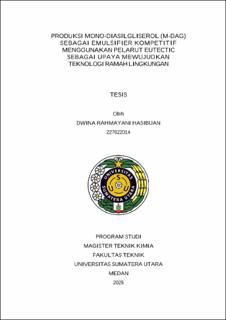Produksi Mono-Diasilgliserol (M-DAG) sebagai Emulsifier Kompetitif Menggunakan Pelarut Eutectic sebagai Upaya Mewujudkan Teknologi Ramah Lingkungan
Production of Mono-Diacylglycerol (M-DAG) as a Competitive Emulsifier Using Eutectic Solvent as an Effort to Realize Friendly Technology Environment

Date
2025Author
Hasibuan, Dwina Rahmayani
Advisor(s)
Manurung, Renita
Iriany
Metadata
Show full item recordAbstract
Mono-Diacylglycerol (M-DAG) is a non-ionic emulsifier that is applicable in various industries. This research optimizes the synthesis of M-DAG through glycerolysis process by utilizing palm fatty acid distillate (PFAD) as raw material, which consists mostly of free fatty acids (FFA). PFAD is used as a raw material in an effort to increase added value in the palm oil industry. The fatty acid glycerolysis process was chosen because the reaction can work at lower temperatures and faster reaction times. The glycerolysis reaction takes place under vacuum condition with PFAD/glycerol molar ratio of 1:4 and the use of eutectic solvent as catalyst synthesized from choline chloride (ChCl)/p-Toluenesulfonate (PTSA) with molar ratio of 1:2. This catalyst was used because it is more environmentally friendly. To obtain M-DAG with optimum results, optimization was carried out with Response Surface Methodology (RSM). The operating conditions studied in this research include catalyst concentration (2, 2.5, 3%), time (90, 105, 120 minutes), and temperature (100, 110, 120°C), with Central Composite Design (CCD) optimization mode. The results showed that the best operating conditions that gave the highest FFA conversion, yield, and M-DAG content were obtained at a catalyst concentration of 2.5%, time 94.6 min and temperature 125.2°C. Statistical data test results showed that the catalyst concentration, time and temperature factors significantly influenced the glycerolysis process of PFAD and glycerol into mono-diacylglycerol (M-DAG) with a confidence level of 99.99%. The optimum condition yielded 40.12% with MAG and DAG content after purification of 74.19% and 18.33% DAG, respectively. The M-DAG product after purification has an emulsion capacity of 88% and a melting point at 60°C.
Collections
- Master Theses [142]
